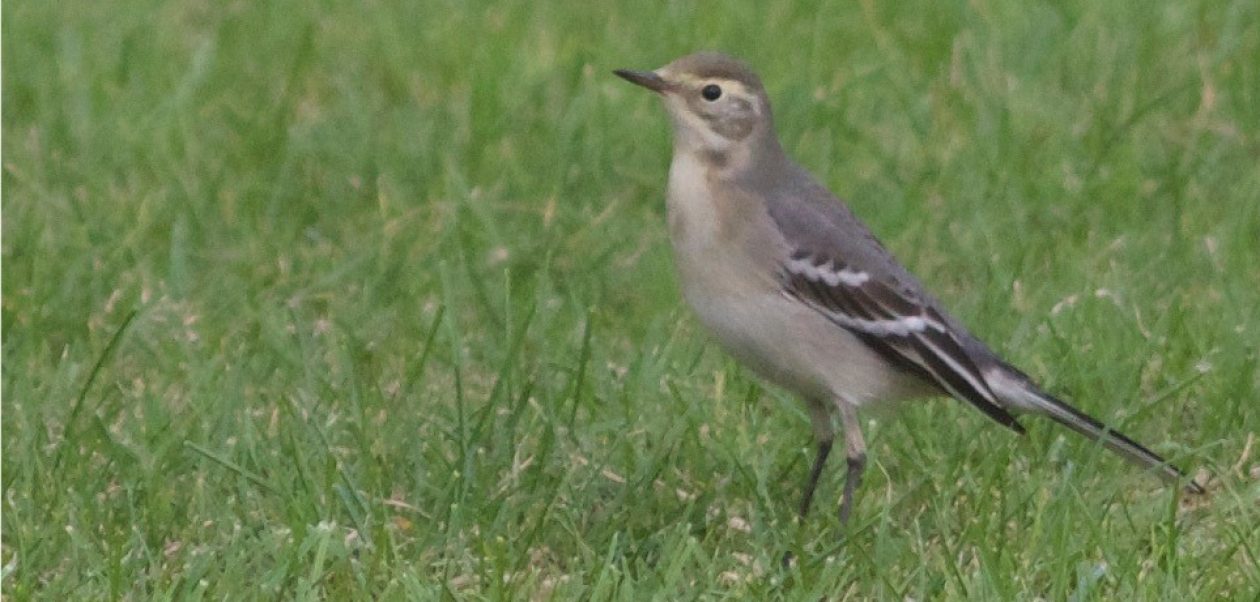150 species recorded so far this year 146 by the same time last year
A total of 99 species for the month was well below the average for the ten previous years of 107 species. There were six additions to the year list all of which would be expected during the year. However, the five Velvet Scoters on 24th was our earliest record (previously 2nd October in 2004) and the Mistle Thrush on 22nd was only the fourth record since the berry-laden holly tree in the churchyard was felled in February 2015.
30th
Sunny with a light WNW wind. The month ended quietly; four Gannets, eight Brent Geese and four Wigeon flew west, there were 12 Little Egrets and two Grey Herons and two Buzzards were seen. One Great Skua was seen. There were now four Stonechats and a Willow Warbler along the east bank.
29th
A quiet morning. Stonechat numbers had increased to three and there was also a Wheatear (only the third this month). No Whinchats were seen. There were 12 Golden Plovers roosting on their favoured part of the beach for the first time this autumn.
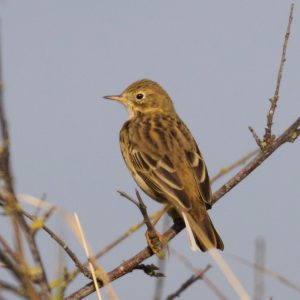
Meadow Pipit – Andy Taylor
28th
A change in weather, cloudy with a fresh NE wind. A Manx Shearwater flew west at 10 am (returning east later) and was an addition to the year list and a Pomarine Skua flew east close inshore. . Other birds on the move included our first Red-throated Diver of the year, 37 Brent Geese, nine Wigeon and four Teal flying west and a late Fulmar flying west. Also, 30+ Common Scoters flew around offshore. A flock of 30 Bar-tailed Godwits flew west and a Snipe flew over the beach. There were two Black Terns fishing offshore, difficult to pick out in the swell. Lastly, there were two Whinchats in the scrub.
27th
Sunny with a light westerly wind. A juvenile Arctic Skua flew west. A Yellow Wagtail flew west over the Obs and two Whinchats and a male Stonechat were in the scrub/grassland area. Also noted were a Kingfisher and a Great Spotted Woodpecker, a Blackcap and eight Chiffchaffs, two Jays and a Reed Bunting.
Two Speckled Wood butterflies were also seen.
26th
A male Stonechat was our first of the autumn.
25th
Sunny and calm. Not the best weather at this time of the year but a juvenile Pomarine Skua, which flew east close inshore, was an addition to the year list (a catch up after the weekend’s activities elsewhere). A second addition was a Little Grebe seen briefly along Coot Strait. This is the first here since November 2016 when a few wintering birds disappeared when the brook was in spate after heavy rain. A single Brent Goose was on the tidal ponds and two Teal were on the beach with another three on the Marsh Pool. Waders included 35 Oystercatchers on the beach on the incoming tide, three Dunlin and a Curlew on the beach and a party of five Redshanks flew west. Two Kingfishers, a male and a female, were clinging to the overhanging vegetation along Coot Strait (we showed them to one of the regular dog walkers who vowed to take up bird-watching!). Five Pied Wagtails on the football pitch were joined briefly by three Grey Wagtails. There were two Whinchats in the scrub, a Reed Warbler in the brambles opposite the Obs and at least seven Chiffchaffs in the area.
A Painted Lady was at the Obs (not many have been seen here this year.
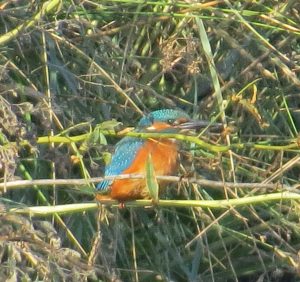
Kingfisher – Geoff Burton
24th
Sunny with a light NW wind. Hoping for some residuals after yesterday’s storms. Not a bad day with the highlights being five Velvet Scoters which came in from the west and landed on the sea (later seen at Reculver by Richard Roberts). A new bird for the year and our earliest of this species (previously 11th October). A Spoonbill that flew west over the beach was our third this year. Two Brent Geese flying west were our first returning birds and other wildfowl included 23 Wigeon west, seven Teal west (and another three on the Marsh Pool), and about 20 Common Scoters. A Marsh Harrier, an Avocet (second record this year), a Bar-tailed Godwit and c10 Great Skuas also flew west. Two auk sp flew east. A count of 102 Turnstones roosting between the groynes courtesy of Philip Hurst.
A Rock Pipit, which landed on the shingle ridge, was our first of the autumn, two Whinchats remained in the scrub and three Reed Buntings flew west.
Butterflies included Large and Small Whites, Comma, Speckled Wood and Common Blue whilst a Common Lizard showed well at the Obs.
23rd
A day of strong northerly winds and driving rain proved an excellent one for sea-watching but these are not good conditions at Swalecliffe. There is little shelter here that will, at the same time, allow observations looking directly north. Therefore, no observations were made! One might speculate as to what might have passed by that day but, with Andy watching from the comfort of his home not half a mile away to the west, we can more than speculate as he noted five species heading from the east that would have been new for the year; these were Sooty and Manx Shearwaters, Leach’s Petrel, Pomarine and Long-tailed Skuas. How many of these will we get back by the end of the year?
22nd
Cloudy with a light westerly wind. A Great Crested Grebe was on the sea, a Bar-tailed Godwit was on the beach and an Arctic Skua flew east. Bird of the day was a Mistle Thrush, which flew into the tallest tree at the back of the sewage works where it remained for about ten minutes. New for the year, this is only the fourth record since the berry-laden holly tree in the churchyard was felled in February 2015. For several winters, this tree had provided sustenance for a very territorial Mistle Thrush. Also noted were two Kingfishers and two Grey Wagtails whilst c15 Meadow Pipits flew west.
20th
Sunny with a freshening SW wind. Another quiet day. A drake Common Scoter flew west, 80 Ringed Plovers were roosting between the groynes at the eastern end of the beach and a Whimbrel flew west. A Hobby circled over the sewage works early morning and a Whinchat was in the scrub.
19th
Light cloud dispersing, light to moderate southerly wind. Waders included 45 Oystercatchers heading east on the outgoing tide with single Dunlin and Redshank on the beach. Four adult Great Black-backed Gulls were also on the beach. There was a steady trickle of Swallows, total 223, moving through until mid-morning but only two Sand Martins and five House Martins. At least five Chiffchaffs were present.
The first Common Darter of the autumn was present along the upper brook bushes.
18th
Ted Lee witnessed some movement with flocks of c15 Knot, 25+ Bar-tailed Godwits and 30+ Common Terns heading west. Also noted was a Kingfisher, Yellow Wagtail and Jay.
17th
Sunny and warm with a light southerly wind. A juvenile Mute Swan, close inshore on the sea, drifted east down to Hampton (and was also seen in the afternoon by Arnie van Orsouw). One Common Scoter flew east and the “resident” Teal was again seen. Waders included a single Whimbrel on the beach and a Sanderling amongst a flock of Ringed Plovers and Turnstones. A Kingfisher was perched on the side of the brook behind the shingle ridge, a Great Spotted Woodpecker was in the churchyard and in flight over the Obs, a Whinchat was in the grassland, and a Wheatear on the beach between the groynes at the eastern end. A Blackcap, four Chiffchaffs (three newly arrived by the beach) and a Willow Warbler were noted and a Reed Bunting was in the bushes opposite the Obs.
Butterflies included two Speckled Woods.
15th
Sunny with a light NW wind. There were 16 Little Egrets gathered together on the shoreline by the Obs early morning; a good count for the site. A single Teal and Common Scoter were noted. A juvenile Marsh Harrier flew west close inshore and a Hobby flying through was the first of the month. Only one Whinchat and one Willow Warbler were seen whilst a Sparrowhawk crashing out of the trees by the Obs left the sound of alarmed Long-tailed Tits in its wake; our first recorded here since June.
13th
Sunny with a light NW wind. One Great Crested Grebe flew east and ten Gannets flew west. There was one Golden Plover (our first this autumn) and three Dunlin on the beach and two Whimbrel. Other birds included a male Great Spotted Woodpecker at the Obs, a Kingfisher along the brook, three Whinchats in the scrub and a Willow Warbler along the east bank.
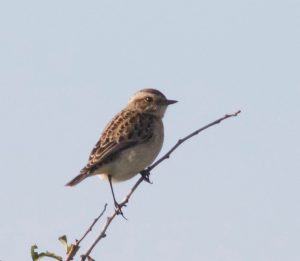
Whinchat – Andy Taylor
On this day in 2008 – a Fan-tailed Warbler was found in the scrub at about 9 am and remained in the area for about three hours before flying off strongly west. This was only the second record for Kent and the sixth for Britain. There have been two records in Kent since then, a long-staying bird at Pegwell Bay in October-December 2009 and a second for Bockhill in March 2010. There has been no further sightings in Kent or in Britain since. Always touted as a species that might colonise from the near Continent, the four records in Kent between 2006 and 2010 might have given credence to this but it has turned out to be another false dawn.
11th
Sunny with a moderate SW wind. A juvenile Mediterranean Gull in transition to first-winter plumage was on the beach. Ten Common Terns (scarce here recently) flew west and, as the tide came in, there were five Little Egrets on the shoreline. One of these was colour-ringed and we traced it to the Southern Colour Ringing Group who have been ringing Little Egrets and Grey Herons at two sites in the Lee Valley since 2015. Our bird was one of a family of three ringed at Netherhall on 10th May this year. The bird was seen at Dartford Marshes on 23rd July before visiting us. This is the first colour ringed Little Egret we have seen here. Most of our colour ringed birds have been gulls and we have now learnt that ringing at the Pitsea Landfill Site, where most of our ringed gulls originate, ceased on 13th March this year because of the lack of food waste and consequently lack of gulls! However, I am sure we will continue to see Pitsea gulls for many years yet.
There was a westerly movement of House Martins this morning, typically in pulses, with 285 being the highest count so far this autumn. Only four Sand Martins and four Swallows were noted. Other birds noted included six Meadow Pipits west, a Whinchat in the scrub and a Willow Warbler along the east bank.
10th
Sunny with a light SW wind. Five Common Scoters flew east, a Teal was on the Marsh Pool where, later, a Snipe dropped in and settled down to sleep. Four Swallows, 11 Meadow Pipits and five Yellow Wagtails flew west and there were three Whinchats in the grassland.
Butterflies included a late Meadow Brown and our first Small Copper. A total of 23 species this year with only Wall, Brown Argus and Purple Hairstreak seen here only in previous years.
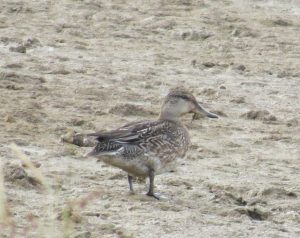
Teal – Geoff Burton
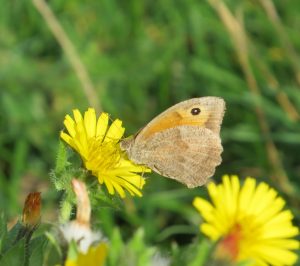
Meadow Brown – Geoff Burton
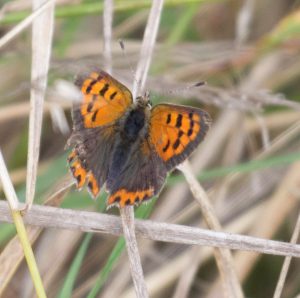
Small Copper – Andy Taylor
8th
Light cloud and a light SW wind. A duck Eider which flew west was our first of the year! Waders included a party of six Ruff west over the sewage works, two Whimbrel and eight Redshanks. Seven Whinchats were together around the bushes opposite the Obs; a high count for this site. Also six Sand Martins and three Yellow Wagtails flew west.
6th
Cloudy with a moderate NW wind. Seven Gannets flew east, 58 Wigeon, including a flock of c50, and 14 Teal flew west. Two Shovelers on the sea flew off west. Waders included one Ruff and one Snipe with 60 Ringed Plovers and 40 Turnstones roosting. Two Arctic Skuas were chasing a Sandwich Tern and another rested on the sea close inshore. Our first movement of Meadow Pipits with c90 birds and also six Sand Martins and three Yellow Wagtails; all flew west. Three Whinchats were in the s crub and another came in off the sea.
5th
Cloudy with a moderate northerly wind and some drizzle. A flock of ten Knot accompanied by a single Ruff and Black-tailed Godwit flew west early morning. Later four Bar-tailed Godwits flew east. Ducks were on the move with 43 Wigeon and 28 Teal flying west and a single Teal was on the Marsh Pool. Four Arctic Skuas and three Great Skuas and c20 Common Terns also flew west. About 50 Swallows flew west and a Whinchat (only our second of the year) was near the scout hut.
4th – Ted Lee’s sea-watch produced 20+ Gannets, two Arctic Skuas and a Great Skua flying west and a Common Scoter and a small Shearwater sp flying east.
Jason Moule saw a Hummingbird Hawkmoth on the buddlea behind the scout hut.
3rd – after a light early morning mist, it was warm with a light northerly wind. Two Bar-tailed Godwits, nine Curlews, a Greenshank and an adult Mediterranean Gull flew west and a party of six Wigeon flew east. However, the highlight of the day came mid-morning when parties of Arctic Skuas – three, five, 13 and two – flew high NW heading towards Sheppey and two single Great Skuas followed the same trajectory. Three Yellow Wagtails flew west, a Lesser Whitethroat was in the scrub and a Willow Warbler at the obs.
1st – a sunny, calm and warm day. Three Common Scoters flew east and four Shelducks flew west. It was nice to have close views of a juvenile Knot on the beach and four Sanderlings were also seen. Two Kingfishers in pursuit flew by the sluice and along the east bank, there was a female Great Spotted Woodpecker and a Garden Warbler along the east bank, a Lesser Whitethroat in the scrub and a Wheatear on the beach in amongst the Ringed Plovers.
Butterflies included Small Heath and the three whites.
